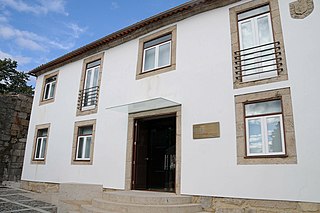
The Palace of the Dukes of Braganza is a medieval estate and former residence of the first Dukes of Braganza, located in the historical centre of Guimarães, in the north-western part of Portugal.

The Castle of Almourol is a medieval castle atop the islet of Almourol in the middle of the Tagus River, located in the civil parish of Praia do Ribatejo, 4 kilometres (2.5 mi) from the municipal seat of Vila Nova da Barquinha, in Portugal's Center Region. The castle was part of the defensive line controlled by the Knights Templar, and a stronghold used during the Portuguese Reconquista.

The Arrábida Bridge is an arch bridge of reinforced concrete which carries six lanes of traffic over the Douro River, between Porto and Vila Nova de Gaia, in the Norte region of Portugal.

The 1 May Stadium is a multi-purpose stadium in civil parish of Braga in the municipality of Braga, in the district of the same name. Built in 1950 to host mostly football matches, the stadium has the capacity to seat 28,000 spectators.
The Monastery of the Mónicas, located in São Vicente, Lisbon, was a Portuguese nunnery dedicated to the mother of Augustine of Hippo, Saint Monica. It later became a prison.

The Convent of Our Lady of Mount Carmel is a former Catholic convent located in the civil parish of Santa Maria Maior, municipality of Lisbon, Portugal. The medieval convent was ruined during the sequence of the 1755 Lisbon earthquake, and the destroyed Gothic Church of Our Lady of Mount Carmel on the southern facade of the convent is the main trace of the great earthquake still visible in the old city.

The Pousada da Ria is situated in the civil parish of Torreira in the municipality of Murtosa, district of Aveiro. It is part of the Pousadas de Portugal network of hostels, classified under the "Pousada of Nature" designation.

The Domus Municipalis is a Romanesque building in the northeastern municipality of Bragança in Portugal. The exact function of this building, even after research completed in the 20th century, is still largely unknown: it could have served as cistern, but there are doubts if this was its primary function.

The Fort of Leça da Palmeira, or alternately the Castle of Matosinhos is a 17th-century fort located in civil parish of Leça da Palmeira, municipality of Matosinhos in the Greater Porto region of Portugal.

The Castle of Belver is a Portuguese castle in the civil parish of Belver, municipality of Gavião, district of Portalegre, in central Portugal.

The Melgaço Museum of Cinema is a museum located in Melgaço. Since 2005, it has been housed in a 19th-century building previously housed in the local customs authority.

The Ponta dos Rosais Lighthouse is a beacon/lighthouse located along the 200 m cliffs of Ponta dos Rosais near Rosais in the extreme northwest of the island of São Jorge, in the Archipelago of the Azores, Portugal. It includes the main tower and several living quarters and auxiliary buildings constructed for the maintenance and operation of the lighthouse, currently abandoned and in ruins. This includes structures such as a motor-pool, a communal hearth and a series of concrete lavoirs for washing, as well as the larger block devoted to administration and private residences.

The Sá de Miranda Secondary School, is a Portuguese Public school in civil parish of São Vicente, in the municipality of Braga, in the northern district of Braga.

The Lighthouse of Praia da Barra, also known as the Aveiro Lighthouse, is an active lighthouse in the civil parish of Gafanha da Nazaré, municipality of Ílhavo, in the Portuguese district of Aveiro. Situated on the coastal Praia da Barra, at the southern margin of the Ria de Aveiro, it is the tallest lighthouse in Portugal, with a height of 203 feet (62 m) overseeing the barrier beach and exposed to Atlantic storms. It is open to the public and visits are held on Wednesdays from 14:00 to 17:00.

The Fort of São João Baptista das Berlengas, or simply known as the Fort of the Berlengas, is located off western coast of Portugal, on the largest island of the archipelago of the Berlengas, in the municipality of Peniche in Oeste region. The fortification belonged to a group of defensive military structures meant to protect the municipality located on the coast.

The Fort of Lagarteira is a medieval fort in the civil parish of Vila Praia de Âncora, municipality of Caminha in the Portuguese Norte, classified as a Property of Public Interest.

The Castle of Pombal, is a medieval castle in the civil parish of Pombal, municipality of the same name in the district of Leiria in the Centre region of Portugal.

The Secondary School Luís de Camões is a secondary school located in the civil parish of Arroios, in the municipality and Portuguese capital of Lisbon, classified as a Monumento de Interesse Público in 2012.

The Walls of Dom Fernando, or Fernandine Walls, are medieval fortifications located in the civil parish of Cedofeita, Santo Ildefonso, Sé, Miragaia, São Nicolau e Vitória, in the municipality of Porto, Portuguese Porto.

The Customhouse of Angra do Heroísmo is a well-preserved Portuguese custom house located in the civil parish of Sé, in the municipality of Angra do Heroísmo, in archipelago of the Azores.





















